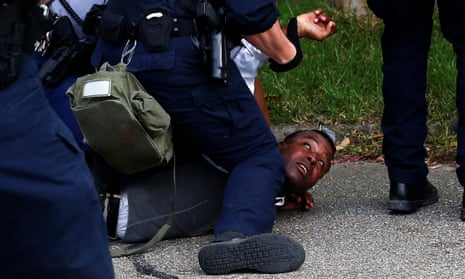Over the weekend, after a tumultuous few days, thousands of protesters returned to American streets to demand an end to police killing black men, women and children.
In some ways it was a surprising development. The shocking murder of five police officers in Dallas threatened to upend the momentum of the Black Lives Matter (BLM) movement, which had been building in response to the killings of two Black men, Alton Sterling and Philando Castile. From Columbus, Ohio, to Chicago to West Palm Beach, Florida, to Atlanta, ordinary people refused to be cowed into silence by those who sought to connect Dallas gunman Micah Johnson to the peaceful and determined activists of BLM.
Former Republican vice-presidential candidate Sarah Palin, using thinly veiled racist language, declared BLM to be a “farce” saying, “shame on politicians and pundits giving credence to thugs reacting against police officers and the rule of law in the name of ‘peaceful protests’”.
The lieutenant governor of Texas, Dan Patrick said he blamed “former Black Lives Matter protests” for creating the conditions that led Johnson to act.
It was not only conservative commentators who desperately tried to connect the movement to the tragedy in Dallas, but police organizations as well. New York City’s largest police union argued that it created an atmosphere of hostility towards police. Patrick Lynch spoke of “erroneous information and inflammatory rhetoric put forward by groups and individuals whose agenda has nothing to do with justice … As we go forward, we need to take an honest, hard look at everything that wrongfully inflames emotions against police officers if we are going to be able to bring police officers and the community together.”
All of these attacks on BLM are intended to create the impression that it’s the activists and organizers that are riling up otherwise placid people. But they have it backwards. The movement does not exist because of its most prominent personalities or spokespeople. It exists because of police brutality and misconduct. In other words, it is not “erroneous information and inflammatory rhetoric” that has inflamed people; rather it’s the regular abuse and racist harassment that sometimes results in the murder of innocent African Americans at the hands of the police that gave birth to the movement.
The brutality of American police, however, does not exist in a vacuum. We are a deeply violent society where in one breath elected officials decry “senseless” shootings and other acts of violence while in the next they justify the use of drones to bomb people in faraway places.
We tend to view the spheres of domestic and foreign policy separately. When Barack Obama delivers pleas for calm in the streets of the United States while he attends a Nato summit in Poland detailing the extent of US military commitments across Europe and the decision to maintain the American occupation of Afghanistan, those two spheres begin to overlap. But when Dallas police used a robot to place a bomb near Micah Johnson, foregoing any due process and summarily executing him, it completely merged those spheres, bringing the “war on terror” home. Deploying the hardware and tactics of the military in domestic policing situation establishes a dangerous precedent.
But perhaps American violence is most acutely evident in the extreme inequality that exists here. This is not a tangential point. It is directly related to the antagonistic relationship police have with the mostly black and Latino communities they monitor and patrol. Much crime in this country is a product of poverty that is then aggravated by the absence of a welfare state that could mitigate its most pernicious effects. Police are deployed to respond to the consequences of poverty and our crumbling civic infrastructure. Black and brown people experience disproportionately high rates of poverty and unemployment, putting them directly into the crosshairs of police departments.
The tensions between communities of color and the police are stoked especially where police are increasingly asked to ticket, fine and arrest in order to generate income in the cities they work for. Philando Castile was stopped at least 52 times by police for a variety of minor driving infractions including speeding, driving without a muffler and not wearing a seatbelt. More than half of the violations he was stopped for were eventually dismissed but he still amassed over $6,500 in fines and fees as a result. Police brutality should not just be measured by physical abuse, wrongful arrest or even by simply counting the dead. It is also evident when black people are seen as sources of municipal funds and not as citizens. When you mix into this cauldron the fact that there are more guns in America than there are people, events like this last week’s are less shocking and more depressingly predictable.
All of this points to the necessary continuation, not the end, of the Black Lives Matter movement. As cautious and concerned as people may be today, we should not let the horrific killing spree in Dallas blind us to the unprecedented rate at which American police kill its own people. Since the beginning of 2016, the police have already killed 571 people with no apparent end in sight. The struggle must go on.
